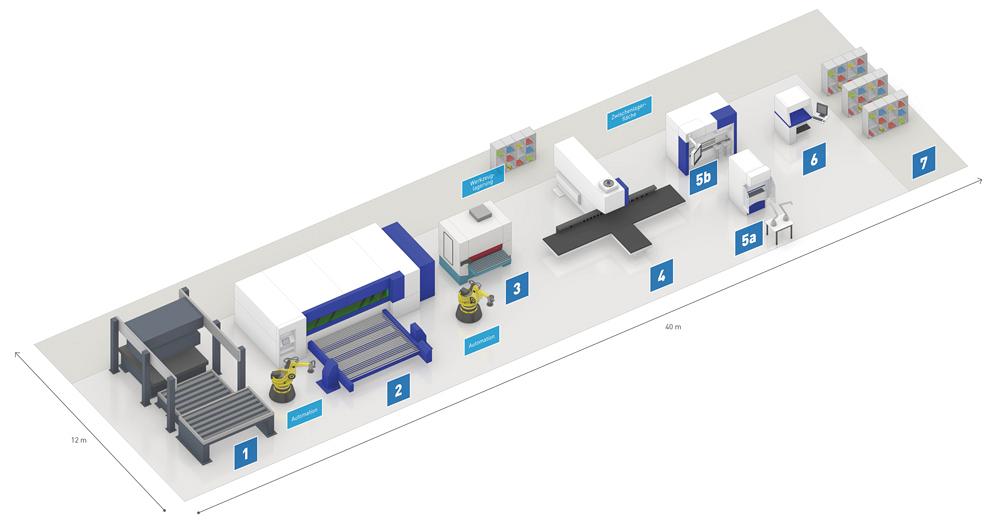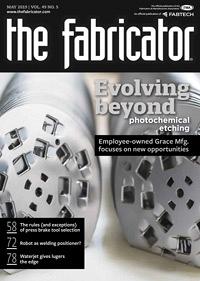Senior Editor
- FMA
- The Fabricator
- FABTECH
- Canadian Metalworking
Categories
- Additive Manufacturing
- Aluminum Welding
- Arc Welding
- Assembly and Joining
- Automation and Robotics
- Bending and Forming
- Consumables
- Cutting and Weld Prep
- Electric Vehicles
- En Español
- Finishing
- Hydroforming
- Laser Cutting
- Laser Welding
- Machining
- Manufacturing Software
- Materials Handling
- Metals/Materials
- Oxyfuel Cutting
- Plasma Cutting
- Power Tools
- Punching and Other Holemaking
- Roll Forming
- Safety
- Sawing
- Shearing
- Shop Management
- Testing and Measuring
- Tube and Pipe Fabrication
- Tube and Pipe Production
- Waterjet Cutting
Industry Directory
Webcasts
Podcasts
FAB 40
Advertise
Subscribe
Account Login
Search
Growing the skilled labor base, one training center at a time
New sheet metal training center in Germany could be a harbinger
- By Tim Heston
- May 20, 2019
- Article
- Shop Management

The labels (not shown) corresponding with the numbers are in German, but the work flow is obvious. This sheet metal training center in Germany, developed by gpdm, incorporates the complete sheet metal fabrication process, from cutting and bending to joining and parts marking.
Sheet metal fabricators in the U.S. tend to hold a positive stereotype of the fabricator in western Europe, and for good reason.
Automation at many European fabricators seems to be the rule rather than the exception, and much of that automation is tailored for extremely high-mix operations. In most custom fabricators I’ve visited overseas, deliveries of one piece aren’t unusual, and orders of several dozen pieces or fewer seem to be the norm.
Many here in the states also tend to hold the European apprenticeship model in high regard, and perhaps with a dose of jealousy. European operations, the thinking goes, benefit from an education system and overall culture that value manufacturing.
Turns out, though, that some European operations suffer from the same skilled labor problems as fabricators stateside. In March I visited Mauser Produktion GmbH, a custom fabricator in Ditzingen, Germany, outside Stuttgart; Oliver Secker, executive director, told me that the company is working with a local university to train new recruits on the subtleties of modern sheet metal work, particularly in the intricacies of process digitization.
But wait, I asked, doesn’t Germany have that wonderful apprenticeship program designed to prepare people for the complexities of modern manufacturing? Yes, I was told—but the thing is, the apprenticeship program so integral to German education doesn’t cover everything. First, a student might apprentice in one specialty—anything from milling to baking and food preparation—but then land a job in another specialty, like sheet metal.
And as Secker and others told me, there’s another problem: Germany’s apprenticeship program doesn’t have a track devoted to sheet metal manufacturing. A graduate who completes an apprenticeship in milling and related metalworking might know about feeds and speeds of a cutting tool, but he or she probably wouldn’t know the first thing about bend allowances in sheet metal forming, the importance of material grain direction on a cutting machine’s nest layout, the basics of punch tool setup, and more.
The skilled labor crisis has evolved into a global issue. More manufacturing technology has meant more specialized training. And regardless of the region or country, most education systems just aren’t designed to handle all that technological specialization.
Markus Kamann hopes to alleviate this problem. Since 1998 his company, gpdm, has offered vocational training in various disciplines and countries, including Germany, China, and India. And in November 2018 he launched the company’s first training center focused on sheet metal fabrication. It’s about an hour’s drive from Hannover, Germany, home of the EuroBLECH show.
As gpdm’s managing director, Kamann takes a market-based approach. That is, he tailors a training center and program around a target audience, and in the case of the new sheet metal training center, he’s built it to serve the needs of a cluster of local sheet metal companies, most of which have between five and 25 employees.
The fabricators pay gpdm so they can send employees for 40 to 60 days of training a year for up to three years. Other clients, like agencies working with government employment programs, might elect to send people for one long stint of training, up to 120 days. Regardless of which approach gpdm’s clients take, the end goal is the same: to develop a work force well-versed in the latest techniques and equipment.
About 85 sheet metal operations are within an hour’s drive of the new training center. “We hosted 12 companies when we opened in November, and now we’re hosting 26,” Kamann said.
He has also partnered with various equipment-makers—everyone from TRUMPF, Remmert, Beosys Software, Siemens, and Weber to Universal Robots—to provide modern equipment that spans the entire sheet metal manufacturing process, from programming and software to cutting, bending, welding, and marking. The demands from local fabricators drives the technology choice and the training regimen.
The entire process Kamann and his team go through to launch a training center, be it in sheet metal or other disciplines, takes less than a year. The first step is the discovery phase, uncovering a local cluster of shops in a certain manufacturing specialty.
“From there it takes us about 10 to 12 months to find out what technologies the shops use, what level of demand they have for training, and what kind of training goes on at the local technical and community colleges,” he said. “Are there skilled workers coming from other manufacturing sectors? Are there [military veterans]? What are our target groups? We have a [launch] process that covers all this and more.”
Metal fabrication has evolved in geographic clusters in certain areas of the U.S.—think of the “ring of fabrication” around Lake Michigan. People start work in one shop, eventually launch their own, and the cycle continues. Problem is, technology has boosted the velocity of fabrication. An unengaged, untrained rookie operator can cut and bend a heck of a lot of wrong parts in a hurry. And metal fab is a small-company business. A 20-employee shop can’t afford to open an elaborate training center on its own.
But what if a cluster of shops sent their unskilled employees to one central training center to learn the fundamentals? Even better, in the spirit of the traditional apprenticeship, these people could learn over time, returning for stints at the training center over several years.
Would such a model work in the states? That’s hard to predict. The U.S. isn’t Europe. That said, industry veterans are retiring in droves during a period of record low unemployment. Thinking anew about training and retention probably isn’t a bad idea.
gpdm, www.gpdm.de
About the Author

Tim Heston
2135 Point Blvd
Elgin, IL 60123
815-381-1314
Tim Heston, The Fabricator's senior editor, has covered the metal fabrication industry since 1998, starting his career at the American Welding Society's Welding Journal. Since then he has covered the full range of metal fabrication processes, from stamping, bending, and cutting to grinding and polishing. He joined The Fabricator's staff in October 2007.
Related Companies
subscribe now

The Fabricator is North America's leading magazine for the metal forming and fabricating industry. The magazine delivers the news, technical articles, and case histories that enable fabricators to do their jobs more efficiently. The Fabricator has served the industry since 1970.
start your free subscription- Stay connected from anywhere

Easily access valuable industry resources now with full access to the digital edition of The Fabricator.

Easily access valuable industry resources now with full access to the digital edition of The Welder.

Easily access valuable industry resources now with full access to the digital edition of The Tube and Pipe Journal.
- Podcasting
- Podcast:
- The Fabricator Podcast
- Published:
- 04/30/2024
- Running Time:
- 53:00
Seth Feldman of Iowa-based Wertzbaugher Services joins The Fabricator Podcast to offer his take as a Gen Zer...
- Industry Events
Pipe and Tube Conference
- May 21 - 22, 2024
- Omaha, NE
World-Class Roll Forming Workshop
- June 5 - 6, 2024
- Louisville, KY
Advanced Laser Application Workshop
- June 25 - 27, 2024
- Novi, MI
Precision Press Brake Certificate Course
- July 31 - August 1, 2024
- Elgin,































